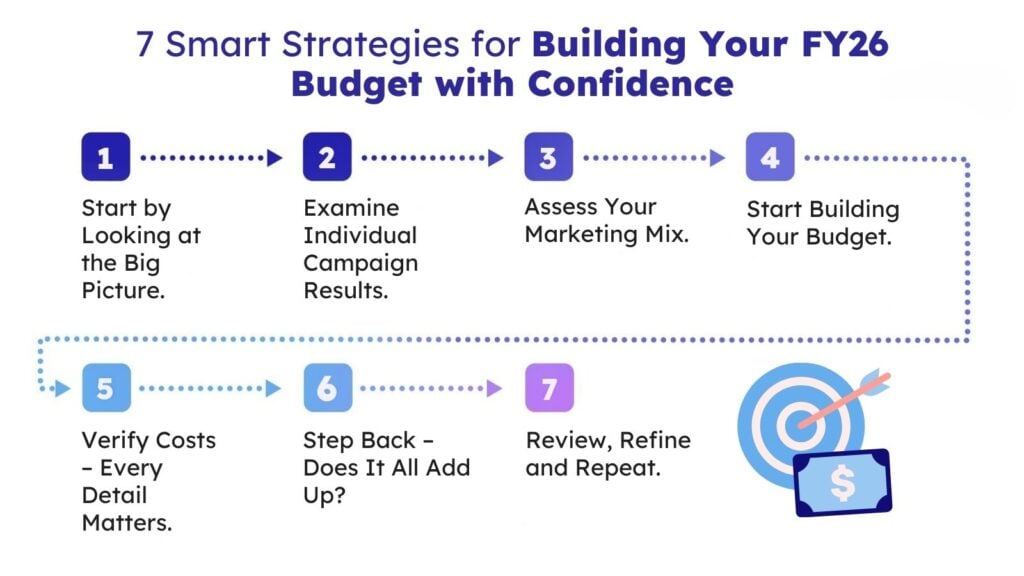A Budget Is Not a Spreadsheet: 7 Steps to Strategic FY26 Planning for Public Media

For many in public media, budget season is upon us. While it’s easy to think of a budget as just a spreadsheet, it’s much more than that. Your budget is a roadmap for the year ahead. It should be based on historical data and current trends and accompanied by a tactical plan that matches costs to realistic revenue expectations.
With a structured approach, you can build a strategic, data-backed budget that will allow you to make the case for new initiatives or increase spending in channels where you’ve been absent, or where there’s untapped potential. This is especially important during this time of uncertainty, when there may be a tendency to automatically pull back on spending or suspend some activities altogether.
Here are 7 Steps to help you build your FY26 budget with confidence and get you where you want to go.

Step 1: Start by Looking at the Big Picture
Before diving into spreadsheets, take a moment to assess where your fundraising program stands. Think of it like planning a trip — you wouldn’t start booking hotels before deciding on a destination. So, where do you want to go? Where do you want to be at the end of FY26?
Start by reviewing trending reports such as AGP’s Donor Performance Analysis. Together, you and your strategist should identify:
- What are your biggest strengths? Where do you see consistent growth?
- What challenges did you face in the past year?
Use the answers to those key questions to define goals by audience segment. This is particularly beneficial for goals around:
- Number of new donors
- Increasing the number of gifts per donor
- Increasing the average gift
This isn’t the time to delve into tactics. That will come next. This step is about answering the question: Where do you want to go?
Step 2: Examine Individual Campaign Results — What Worked and What Didn’t
Now that you know where you want to go, Step 2 will help you determine how you’re going to get there. This is the time to zoom in on campaign performance.
Understanding what worked and what didn’t yields valuable insights you can leverage in next year’s budget.
- Dig into the details: Look at each campaign in its totality. Then, look at every audience segment within the campaign. What appears to be an under-performing campaign at first blush may be a winning campaign in disguise! One where overall results were dragged down by just one audience segment. Conversely, what looks like a successful campaign could be one that’s lackluster, but overall results are boosted by strong mid/major donor performance.
- Iterate and optimize: This is where you can start to go over last year’s strategy and look for ways to improve performance for the year ahead.
- Identify testing opportunities: With limited budgets, focus on offer and audience segmentation testing rather than creative tests, which can often be more costly.
The more you learn from last year’s results, the more strategic and data-driven your FY26 budget will be.
Step 3: Assess Your Marketing Mix — Are You Investing in the Right Places?
Now that you’ve reviewed campaign performance, take a step back and evaluate how each marketing channel contributes to your overall goals. Is there a channel you should be leaning into more heavily? One where it’s more efficient to pull back and reinvest elsewhere?
- Which channels consistently deliver strong results?
- Where is performance lagging?
Assess your marketing mix — direct mail, digital, email, social media, SMS, and on-air – to determine where your dollars are working and where adjustments are needed.
For example:
- Digital acquisition gaining traction? Many stations are experiencing growth here due to Passport. Before you increase spending on digital ads and email marketing, however, evaluate the revenue per donor and retention rates for these new donors and compare these KPIs to new donor performance from other acquisition sources. Where should you lean in?
- Direct mail still a top performer? For many stations, this channel drives a significant amount of revenue. Are you utilizing this channel to its full potential? Direct Mail Renewals typically drive the majority of mail revenue — are you mailing enough efforts? Too many?
The answers to these questions should be reflected in your budget.
You’ll want to ensure that every investment aligns with your goals by audience, which will result in allocating resources strategically and maximizing your ROI.
Stations across the nation are proving that new approaches can deliver growth even in a challenging landscape
Step 4: Now — And Only Now — Start Building Your Budget
With all these insights in mind, open your spreadsheet. Instead of simply adjusting last year’s numbers, you’re now in a position to build your budget campaign by campaign — all in alignment with your over-arching goals.
For each campaign consider:
- What’s staying the same?
- What’s changing?
- What new initiatives or tests will you introduce?
- What are realistic KPIs based on past performance and current trends?
Construct your budget from the ground up — ensuring that every investment is strategic and that data informs every decision.

Step 5: Verify Costs — Every Detail Matters
Underestimating costs can throw your entire plan off track. A well-planned budget sets realistic revenue goals while ensuring that expenses are accurately projected.
- Check in with internal teams and vendors to confirm cost estimates for print production, postage, digital ads and platform fees.
- Factor in likely increases for postage rates and digital media.
A thoughtful, well-planned budget allows for both expected and unexpected costs, allowing your team to pivot when necessary, without disrupting fundraising momentum.
Step 6: Step Back — Does it All Add Up?
Once you’ve drafted your budget, step away from the campaign-by-campaign details and take a big-picture look to confirm that all the tactics support your primary objectives by audience. Reflect on this:
- Does every investment have a clear strategic purpose?
- Are revenue projections grounded in performance data and current trends?
- Are investments in each marketing channel justified based on results?
If something doesn’t add up, make adjustments. You may have unintentionally over-invested in one channel while under-funding another. Or your revenue targets might need recalibrating – whether they’re too ambitious or too conservative. The goal is to ensure your budget aligns strategically and financially.
Step 7: Review, Refine and Repeat
Think of your budget as a living document — not a one-and-done task. Once you have budget approval, revisit this document often throughout the year, comparing campaign performance to projections. Use this data to inform subsequent campaigns and pivot as needed.
Final Thoughts: Let’s Build a Smarter Budget Together
Your FY26 budget is more than a spreadsheet — it’s a data-driven plan that will guide all your activities for the year ahead.
If you need help with refining your strategy, let’s connect. From budgeting best practices to public media CRM solutions, engagement strategies, and direct response campaigns, we’re here to help.
Reach out to me at [email protected] for more info.
Let’s build an FY26 budget that aligns with your goals and maximizes your fundraising potential.
About Debbie Merlino

Debbie Merlino is the EVP of Client Relationships at Allegiance Group + Pursuant. She brings decades of experience helping nonprofit organizations uncover growth opportunities, navigate complex challenges, and build strategies that drive sustainable results. She has a deep understanding of the public media space and the unique dynamics that shape its fundraising programs.
Debbie is known for her ability to balance high-level strategy with hands-on implementation — ensuring every plan is actionable, measurable, and rooted in reality. Her collaborative approach, passion for the mission, and trademark sense of humor make her a trusted partner to both clients and colleagues alike.